Top Story
Pedestrian Perspective: What Can You Learn by Taking a Walk Around Your Neighborhood?
August 30, 2018
The ULI Health Leaders Network is empowering real estate and land use professionals with the skills, knowledge, and networks to improve health outcomes in their professional practice and communities. The 32 Health Leaders who were selected for Cohort 1, which ran from October 2017 to June 2018, undertook a series of activities, including in-person gatherings, learning-focused webinars with leaders in the health and built-environment field, small group work, and individual assignments.
With motorized transportation so prevalent as a means to get around in the United States, getting to understand real conditions on the ground—and how they impact non-motorists—through walking can be an eye-opening experience and help land use and health professionals understand how built environment barriers have real consequences to public health.
By taking a walk near their homes and offices, ULI Health Leaders experienced the disconnects in transportation networks, the importance of community gathering spaces and availability of healthy food, and certain inequities that may exist for subsets of the population. Health Leaders explored different types of neighborhoods—urban, suburban, and rural—in locations across the country, and had important, and strikingly similar, observations that impact health and equity.
Intentionally looking at how the built environment impacts physical activity, access to healthy food, healthy environments, and social well-being can change perspectives:
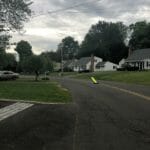 Erin Patterson, Vice President with JLL Consulting in New York, found through a walking assessment that her suburban neighborhood in Fairfield County, Connecticut was not as health promoting as she originally believed:
Erin Patterson, Vice President with JLL Consulting in New York, found through a walking assessment that her suburban neighborhood in Fairfield County, Connecticut was not as health promoting as she originally believed:
“What first struck me were the extreme differences in what exists that either encourage or detract from a health and equity standpoint. I began this assessment thinking the immediate area around my home was quite equitable and offered a healthy environment for residents. After really digging in however, a lot of the inequity and accessibility challenges surfaced. What is most ironic to me is the value placed on sports and physical fitness/activity in my town. It is an undercurrent everywhere we go—by car, that is! There is so much more that can be done, and with new mixed-use developments nearby on the horizon, I am more encouraged to get involved and increase the health and wellness equity in my town.”
There are often tradeoffs between built environment improvements and who can access them:
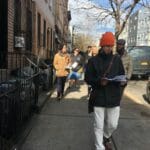 Emily Kurtz, Vice President of Housing at RiseBoro Community Partnership in Brooklyn, New York, assessed the area around her office in the Bushwick neighborhood with colleagues and found that there can be unseen factors that impact health:
Emily Kurtz, Vice President of Housing at RiseBoro Community Partnership in Brooklyn, New York, assessed the area around her office in the Bushwick neighborhood with colleagues and found that there can be unseen factors that impact health:
“Assessing assets and opportunities of our neighborhood gets tricky. On the one hand, access to fresh fruit and vegetables has increased. But so too have the costs of these goods. The community still suffers high rates of asthma and obesity, the emergency rooms in hospitals are still overrun with the chronically homeless, and now low-income tenants are 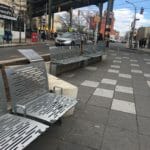 potentially facing harassment and displacement, causing stress. Displacement and fear of displacement are social determinants of health, but as they may not be readily apparent I want to highlight that this is a reality of our built environment that is having a significant impact in our community.”
potentially facing harassment and displacement, causing stress. Displacement and fear of displacement are social determinants of health, but as they may not be readily apparent I want to highlight that this is a reality of our built environment that is having a significant impact in our community.”
Land use professionals must partner with residents to understand true impacts on health.
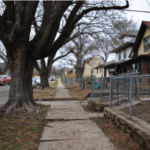 Ina Anderson, Deputy Director at Greater Kansas City LISC, worked with a research team from the University of Kansas and community residents to do a walking audit of a four to six block area in the Scarritt Renaissance neighborhood, identified by residents as an area where they wanted to better understand how street-level conditions impact health:
Ina Anderson, Deputy Director at Greater Kansas City LISC, worked with a research team from the University of Kansas and community residents to do a walking audit of a four to six block area in the Scarritt Renaissance neighborhood, identified by residents as an area where they wanted to better understand how street-level conditions impact health:
“There is a lot of work to do to ensure that this small part of the neighborhood is better connected to the resources that are provided by the nearby commercial corridor including public transit and (limited) retail. Making the streets safer and more welcoming and providing destinations for gathering within the neighborhood will be instrumental to making this area a healthier community across all of the categories that contribute to a place that promotes health and well-being.”
Mixed built environment conditions can create health and equity issues:
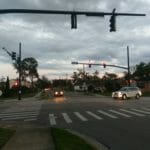 Luis Nieves-Ruiz, Economic Development Program Manager at the East Central Florida Regional Planning Council, walked six blocks of Canton Avenue in Winter Park from his home to the SunRail commuter line he takes to work and found a mix of conditions along the way in terms of sidewalk conditions and land uses:
Luis Nieves-Ruiz, Economic Development Program Manager at the East Central Florida Regional Planning Council, walked six blocks of Canton Avenue in Winter Park from his home to the SunRail commuter line he takes to work and found a mix of conditions along the way in terms of sidewalk conditions and land uses:
“Canton Avenue provides a good snapshot of existing conditions within the City of Winter Park. Based the recommendations from ULI’s Building Healthy Places Toolkit, City leaders have mostly created a built environment that promotes health and physical activity. Most blocks incorporate a mix of land uses, are part of a well- designed and connected street network, have a pedestrian oriented streetscape and adequate sidewalks. When it comes to promoting equity though, the City could do a better job by improving lighting and sidewalks on Canton’s residential blocks.”
Interested in conducting your own walking audit to assess the health of your neighborhood? Use the 21 Building Healthy Places Toolkit recommendations as a starting point and let us know your findings by commenting below or emailing us at [email protected].